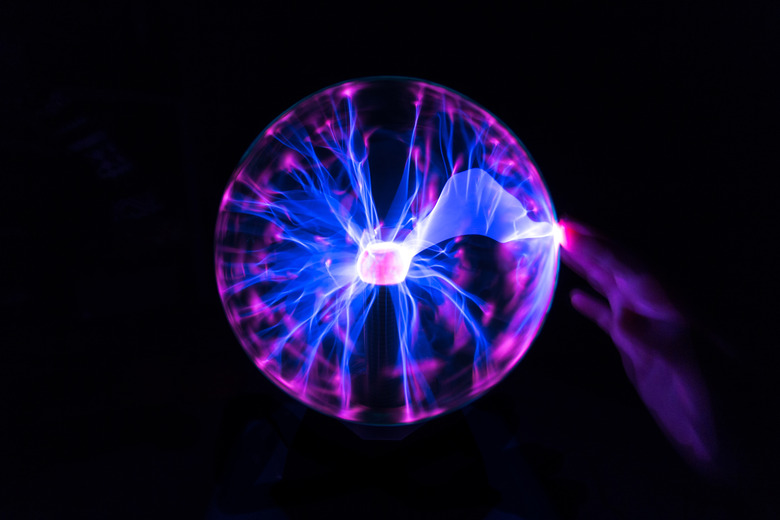How To Make A Lightning Bolt In A Bottle
If you've ever walked across a carpet on a dry day and then touched something made of metal, such as a refrigerator handle, you've experienced lightning firsthand. The static discharge that gave you a shock is the same phenomenon that creates the fiery forks that split the sky during a thunderstorm. Real lightning is caused by the discharge of millions of volts of electricity, which can kill you. Even relatively tiny discharges of static electricity on a refrigerator handle are painful. However, it is possible to safely and painlessly make lightning happen in a jar, where you can study and appreciate it all you want.
What Is Lightning?
Lightning is electric discharge, which is the flow of electrons from a pole with an excess of these particles to another pole with a deficiency. The magnitude of the difference in electrons between these poles is called the voltage, and the greater it is, the stronger will be the electric current when it starts to flow.
During a thunderstorm, water droplets in the clouds collide with one another, releasing electrons in the process. The electrons are attracted to the earth, which is positively charged with respect to the clouds. They can't flow easily through air, however, because air is an electric insulator. Consequently, they build up, like water behind a dam, until the voltage becomes so great that even air can't stop them. At that point, a lightning bolt occurs.
Why Do People Get Shocked by Refrigerators?
When you walk across a carpet, the action of your shoes against the material creates free electrons much in the same way that colliding water molecules in clouds do. The electrons build up in your body, and when your finger gets close enough to anything through which they can flow to earth, they jump through the air in a spark of electric discharge. Metal objects are good conductors of electricity, so many static shocks occur near refrigerator handles and doorknobs. A small flash of lightning occurs at the moment you are shocked, but you're usually too surprised to notice it.
Making Lightning in a Jar
It's easy to create an electric discharge inside any jar that has a metal cap. You just need to do two things. The first is to make an electrode in the bottom of the jar toward which the electricity can flow, and the second is to come up with a safe source of static electricity.
Have you ever rubbed a balloon in your hair and noticed that it sticks to the wall? That's because the action of rubbing the ballon creates free electrons, much like rubbing your feet on a carpet. A balloon makes a great source of static electricity.
Things Needed
- A jar with a metal lid
- Aluminum foil
- A dryer sheet
- A handful of thumbtacks with unpainted metal heads
- A balloon
1. Set Up the Anode
The anode is the positively charged electrode at the bottom of the jar toward which the electrons will flow. To create it, cut a piece of aluminum foil into a square about 12 inches long and 12 inches wide. Fold it twice over into a smaller square and push it into the bottom of the jar. It's OK if the edges stick up a bit.
2. Set Up the Cathode
The cathode is the negatively charged electrode from which the electrons will flow. Make it by poking several thumbtacks through a dryer sheet with their heads facing the top of the jar. Place the dryer sheet over the mouth of the jar and screw on the lid.
TL;DR (Too Long; Didn't Read)
The purpose of the tacks is to focus the charge and increase the voltage. If you used aluminum foil to make the cathode, the charge would spread over the entire sheet instead of flowing toward the anode.
3. Charge the Balloon
Rub the balloon on your head. You'll know it's charged if your hair stands on end when you pull the balloon away.
4. Make Lightning
Touch the balloon to the top of the jar and watch what happens. If the balloon has enough charge, you'll see several yellowish blue flashes of lightning. They'll be even more impressive if you turn down the lights.
TL;DR (Too Long; Didn't Read)
This experiment works best when the humidity is low. That's because moisture makes air an even better electrical insulator.
Cite This Article
MLA
Deziel, Chris. "How To Make A Lightning Bolt In A Bottle" sciencing.com, https://www.sciencing.com/make-lightning-bolt-bottle-10057255/. 13 March 2018.
APA
Deziel, Chris. (2018, March 13). How To Make A Lightning Bolt In A Bottle. sciencing.com. Retrieved from https://www.sciencing.com/make-lightning-bolt-bottle-10057255/
Chicago
Deziel, Chris. How To Make A Lightning Bolt In A Bottle last modified March 24, 2022. https://www.sciencing.com/make-lightning-bolt-bottle-10057255/
